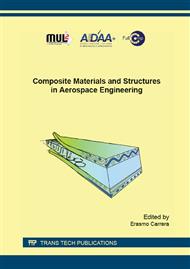[1]
R. M. Christensen. Mechanics of Composite Materials. Wiley-Interscience, New York, (1979).
Google Scholar
[2]
S. Nemat-Nasser and M. Hori. Micromechanics: Overall Properties of Heterogeneous Materials. North-Holland, Amsterdam, (1993).
DOI: 10.1016/b978-0-444-89881-4.50004-9
Google Scholar
[3]
G. W. Milton. The Theory of Composites. Cambridge University Press, Cambridge, UK, (2002).
Google Scholar
[4]
J. Qu and M. Cherkaoui. Fundamentals of Micromechanics of Solids. Wiley, New Jersey, (2006).
Google Scholar
[5]
V. Buryachenko. Micromechanics of Heterogeneous Materials. Springer, New York, (2007).
Google Scholar
[6]
S. Li and G. Wang. Introduction to Micromechanics and Nanomechanics. World Scientific, New Jersey, (2008).
Google Scholar
[7]
H. J. Bohm. A short introduction to basic aspects of continuum micromechanics. Technical Report ILSB Report/ILSB-Arbeitsbericht 206, (2012).
Google Scholar
[8]
R. Hill. The elastic behavior of crystalline aggregate. Proc. Phys. Soc. London, A65: 349-354, (1952).
Google Scholar
[9]
Z. Hashin and S. Shtrikman. A variational approach to the theory of the elastic behaviour of polycrystals. Journal of Mechanics and Physics of Solids, 10: 343-352, (1962).
DOI: 10.1016/0022-5096(62)90005-4
Google Scholar
[10]
S. Torquato. Random heterogeneous materials. Springer New York, (2002).
Google Scholar
[11]
J. Aboudi. A continuum theory for fiber-reinforced elastic-visoplastic composites. International Journal of Engineering Science, 20(5): 605 - 621, (1982).
DOI: 10.1016/0020-7225(82)90115-x
Google Scholar
[12]
J. Aboudi. Micromechanical analysis of composites by the method of cells. Applied Mechanics Reviews, 42(7): 193 - 221, (1989).
DOI: 10.1115/1.3152428
Google Scholar
[13]
M. Paley and J. Aboudi. Micromechanical analysis of composites by the generalized cells model. Mechanics of Materials, 14: 127-139, (1992).
DOI: 10.1016/0167-6636(92)90010-b
Google Scholar
[14]
J. Aboudi, M. J. Pindera, and S. M. Arnold. Linear thermoelastic higher-order theory for periodic multiphase materials. Journal of Applied Mechanics, 68: 697-707, (2001).
DOI: 10.1115/1.1381005
Google Scholar
[15]
T. O. Williams. A two-dimensional, higher-oder, elasticity-based micromechanics model. International Journal of Solids and Structures, 42: 1009-1038, (2005).
DOI: 10.1016/j.ijsolstr.2004.06.057
Google Scholar
[16]
A. Bensoussan, J. Lions, and G. Papanicolaou. Asymptotic Analysis for Periodic Structures. North-Holland, Amsterdam, (1978).
Google Scholar
[17]
H. Murakami and A. Toledano. A higer-order mixture homogenization of bi-laminated composites. Journal of Applied Mechanics, 57: 388-396, (1990).
DOI: 10.1115/1.2892002
Google Scholar
[18]
J. M. Guedes and N. Kikuchi. Preprocessing and postprocessing for materials based on the homogenization method with adaptive finite element method. Computer Methods in Applied Mechanics and Engineering, 83: 143-198, (1990).
DOI: 10.1016/0045-7825(90)90148-f
Google Scholar
[19]
J. C. Michel, H. Moulinec, and P. Suquet. Effective properties of composite materials with periodic microstructure: a computational approach. Computer Methods in Applied Mechanics and Engineering, 172: 109-143, (1999).
DOI: 10.1016/s0045-7825(98)00227-8
Google Scholar
[20]
C. T. Sun and R. S. Vaidya. Prediction of composite properties from a representative volume element. Composites Science and Technology, 56: 171 - 179, (1996).
DOI: 10.1016/0266-3538(95)00141-7
Google Scholar
[21]
H. Berger, S. Kari, U. Gabbert, R. Rodriguez-Ramos, J. Bravo-Castillero, R. Guinovart-Diaz, F. Sabina, and G.A. Maugin. Unit cell models of piezoelectric fiber composites for numerical and analytical calculation of effective properties. Smart Materials and Structures, 15: 451-458, (2006).
DOI: 10.1088/0964-1726/15/2/026
Google Scholar
[22]
S Ghosh. Micromechanical Analysis and Multi-Scale Modeling Using the Voronoi Cell Finite Element Method. Taylor & Francis US, Florida, (2010).
DOI: 10.1201/b10903
Google Scholar
[23]
W. Yu. Structure genome: Fill the gap between materials genome and structural analysis. In Proceedings of the 56th Structures, Structural Dynamics and Materials Conference, Kissimmee, Florida, Jan. 5-9 2015. AIAA.
DOI: 10.2514/6.2015-0201
Google Scholar
[24]
R. Hill. Elastic properties of reinforced solids: Some theoretical principles. Journal of Mechanics and Physics of Solids, 11: 357-372, (1963).
DOI: 10.1016/0022-5096(63)90036-x
Google Scholar
[25]
Z. Hashin. Analysis of composite materials-a survey. Applied Mechanics Review, 50: 481-505, (1983).
Google Scholar
[26]
W. Drugan and J. Willis. A micromechanics-based nonlocal constitutive equations and estimates of representative volume element size for elastic composites. Journal of Mechanics and Physics of Solids, 44: 497-524, (1996).
DOI: 10.1016/0022-5096(96)00007-5
Google Scholar
[27]
M. Ostoja-Starzewski. Microstructural randomness verse representative volume element in thermomechanics. Journal of Applied Mechanics, 69: 25-30, (2002).
DOI: 10.1115/1.1410366
Google Scholar
[28]
B. Liu, X. Feng, and Zhang S. M. The effective Young's modulus of composites beyond the Voigt estimation due to the Poisson effect. Composite Science and Technology, 69: 2198 - 2204, (2009).
DOI: 10.1016/j.compscitech.2009.06.004
Google Scholar
[29]
S. J. Hollister and N. Kikuchi. A comparison of homogenization and standard mechanics analyses for periodic porous composites. Computational Mechanics, (1992).
DOI: 10.1007/bf00369853
Google Scholar
[30]
Sanchez-Palencia and A. Zaoui. Elements of homogenization for inelastic solid mechanics. In Homogenization Techniques in Composites, pages 194-278. Springer-Verlag, (1987).
Google Scholar
[31]
A. Drago and M. -J. Pindera. Micro-macromechanical analysis of heterogeneous materials: Macroscopically homogeneous vs periodic microstructures. Composite science and Technology, 67: 1243-1263, (2007).
DOI: 10.1016/j.compscitech.2006.02.031
Google Scholar
[32]
D. H. Pahr and H. J. Bohm. Assessment of mixed uniform boundary conditions for predicting the mechanical behavior of elastic and inelastic discontinuously reinforced composites. CMES, 34: 117-136, (2008).
Google Scholar
[33]
K. Terada, M. Hori, T. Kyoya, and N. Kikuchi. Simulation of the multi-scale convergence in computational homogenization approaches. International Journal of Solids and Structures, 37: 2285-2311, (2000).
DOI: 10.1016/s0020-7683(98)00341-2
Google Scholar
[34]
N. S. Bakhvalov. Homogenization of partial differential operators with rapidly oscillating coefficients. Soviet Mathematics - Doklady, 16: 351-355, (1975).
Google Scholar
[35]
F. Devries and F. Lene. Homogenization at set macroscopic stress: Numerical implementation and application. Recherche Aerospatiale, 1: 34-51, (1987).
Google Scholar
[36]
J. Fish, K. Shek, M. Pandheeradi, and M. Shephard. Computational plasticity for composite structures based on mathematical homogenization: Theory and practice. Computer Methods in Applied Mechanics and Engineering, 148: 53-73, (1997).
DOI: 10.1016/s0045-7825(97)00030-3
Google Scholar
[37]
V. L. Berdichevsky. Variational Principles of Continuum Mechanics, volume 1 and 2. Springer Berlin, (2009).
Google Scholar


